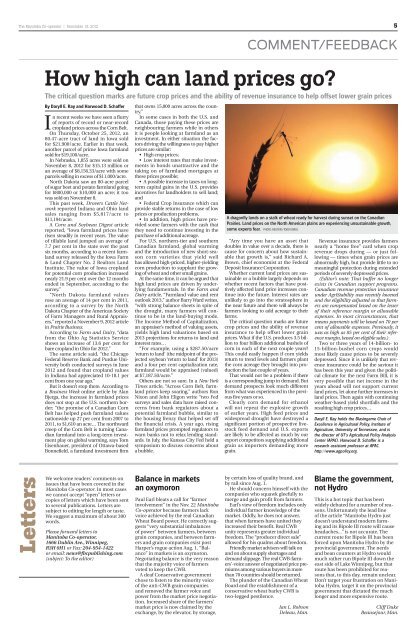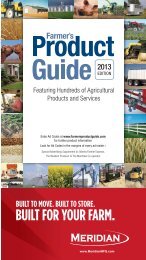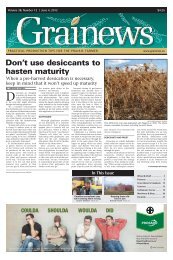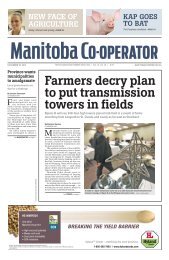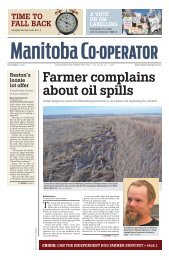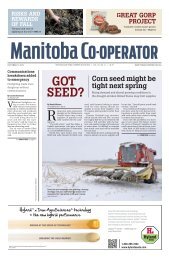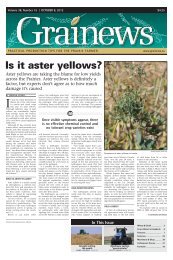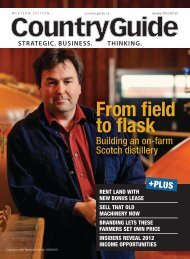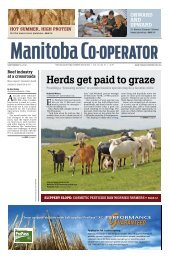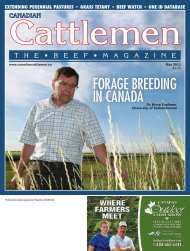National exposé is not a balanced view: MPC
National exposé is not a balanced view: MPC
National exposé is not a balanced view: MPC
You also want an ePaper? Increase the reach of your titles
YUMPU automatically turns print PDFs into web optimized ePapers that Google loves.
The Manitoba Co-operator | December 13, 2012 5<br />
Letters<br />
By Daryll E. Ray and Harwood D. Schaffer<br />
In recent weeks we have seen a flurry<br />
of reports of record or near-record<br />
cropland prices across the Corn Belt.<br />
On Thursday, October 25, 2012, an<br />
80.47-acre tract of land in Iowa sold<br />
for $21,900/acre. Earlier in that week,<br />
a<strong>not</strong>her parcel of prime Iowa farmland<br />
sold for $19,100/acre.<br />
In Nebraska, 1,855 acres were sold on<br />
November 8, 2012 for $15.13 million or<br />
an average of $8,156.33/acre with some<br />
parcels selling in excess of $11,000/acre.<br />
North Dakota saw an 80-acre parcel<br />
of sugar beet and potato farmland going<br />
for $800,000 or $10,000 an acre; it too<br />
was sold on November 8.<br />
Th<strong>is</strong> past week, Drovers Cattle Network<br />
reported Indiana and Ohio land<br />
sales ranging from $5,817/acre to<br />
$11,194/acre.<br />
A Corn and Soybean Digest article<br />
reported, “Iowa farmland prices have<br />
r<strong>is</strong>en steadily in recent years. The value<br />
of tillable land jumped an average of<br />
7.7 per cent in the state over the past<br />
six months, according to a recent farmland<br />
survey released by the Iowa Farm<br />
& Land Chapter No. 2 Realtors Land<br />
Institute. The value of Iowa cropland<br />
for potential corn production increased<br />
nearly 21.9 per cent over the 12 months<br />
ended in September, according to the<br />
survey.”<br />
“North Dakota farmland values<br />
rose an average of 14 per cent in 2011,<br />
according to a survey by the North<br />
Dakota Chapter of the American Society<br />
of Farm Managers and Rural Appra<strong>is</strong>ers,”<br />
reported a November 9, 2012 article<br />
in Prairie Business.<br />
According to Farm and Dairy, “data<br />
from the Ohio Ag Stat<strong>is</strong>tics Service<br />
shows an increase of 13.6 per cent for<br />
bare cropland in Ohio for 2012.”<br />
The same article said, “the Chicago<br />
Federal Reserve Bank and Purdue University<br />
both conducted surveys in June<br />
2012 and found that cropland values<br />
in Indiana had appreciated 10-18.1 per<br />
cent from one year ago.”<br />
But it doesn’t stop there. According to<br />
a Business Week online article by Alan<br />
Bjerga, the increase in farmland prices<br />
does <strong>not</strong> stop at the U.S. northern border;<br />
“the prom<strong>is</strong>e of a Canadian Corn<br />
Belt has helped push farmland values<br />
nationwide up 27 per cent from 2007 to<br />
2011, to $1,610 an acre… The northward<br />
creep of the Corn Belt <strong>is</strong> turning Canadian<br />
farmland into a long-term investment<br />
play on global warming, says Tom<br />
E<strong>is</strong>enhauer, president of Ottawa-based<br />
Bonnefield, a farmland investment firm<br />
We welcome readers’ comments on<br />
<strong>is</strong>sues that have been covered in the<br />
Manitoba Co-operator. In most cases<br />
we can<strong>not</strong> accept “open” letters or<br />
copies of letters which have been sent<br />
to several publications. Letters are<br />
subject to editing for length or taste.<br />
We suggest a maximum of about 300<br />
words.<br />
Please forward letters to<br />
Manitoba Co-operator,<br />
1666 Dublin Ave., Winnipeg,<br />
R3H 0H1 or Fax: 204-954-1422<br />
or email: news@fbcpubl<strong>is</strong>hing.com<br />
(subject: To the editor)<br />
that owns 15,000 acres across the country.”<br />
In some cases in both the U.S. and<br />
Canada, those paying these prices are<br />
neighbouring farmers while in others<br />
it <strong>is</strong> people looking at farmland as an<br />
investment. In either situation the factors<br />
driving the willingness to pay higher<br />
prices are similar:<br />
• High crop prices;<br />
• Low interest rates that make investments<br />
in bonds unattractive and the<br />
taking on of farmland mortgages at<br />
these prices possible;<br />
• A possible increase in taxes on longterm<br />
capital gains in the U.S. provides<br />
incentives for landholders to sell land;<br />
and<br />
• Federal Crop Insurance which can<br />
provide stable returns in the case of low<br />
prices or production problems.<br />
• In addition, high prices have provided<br />
some farmers with the cash that<br />
they need to continue investing in the<br />
purchase of additional acreage.<br />
For U.S. northern-tier and southern<br />
Canadian farmland, global warming<br />
and the introduction of new short-season<br />
corn varieties that yield well<br />
has allowed high-priced, higher-yielding<br />
corn production to supplant the growing<br />
of wheat and other small grains.<br />
At the same time, it can be argued that<br />
high land prices are driven by underlying<br />
fundamentals. In the Farm and<br />
Dairy article, “Farmland value and rent<br />
outlook 2013,” author Barry Ward writes,<br />
“with strong balance sheets in spite of<br />
the drought, many farmers will continue<br />
to be in the land-buying mode.<br />
The Income Method of Capitalization,<br />
an appra<strong>is</strong>er’s method of valuing assets,<br />
yields high land valuations based on<br />
2013 projections for returns to land and<br />
interest rates…<br />
“For example, using a $287.50/acre<br />
‘return to land’ (the midpoint of the projected<br />
soybean ‘return to land’ for 2013)<br />
and a four per cent capitalization rate,<br />
farmland would be appra<strong>is</strong>ed (valued)<br />
at $7,187.50/acre.”<br />
Others are <strong>not</strong> so sure. In a New York<br />
Times article, “Across Corn Belt, farmland<br />
prices keep soaring,” authors Ron<br />
Nixon and John Eligon write “two Fed<br />
surveys and sales data have ra<strong>is</strong>ed concerns<br />
from bank regulators about a<br />
potential farmland bubble, similar to<br />
the housing frenzy that helped set off<br />
the financial cr<strong>is</strong><strong>is</strong>. A year ago, r<strong>is</strong>ing<br />
farmland prices prompted regulators to<br />
warn banks <strong>not</strong> to relax lending standards.<br />
In July, the Kansas City Fed held a<br />
symposium to d<strong>is</strong>cuss concerns about<br />
a bubble.<br />
Balance in markets<br />
an oxymoron<br />
Paul Earl bleats a call for “farmer<br />
involvement” in the Nov. 22 Manitoba<br />
Co-operator because farmers lack<br />
voice achieved by the real Canadian<br />
Wheat Board power. He correctly suggests<br />
“very substantial imbalances<br />
of power” between farmers, between<br />
grain companies, and between farmers<br />
and grain companies ex<strong>is</strong>t post<br />
Harper’s rogue action Aug. 1. “Balance”<br />
in markets <strong>is</strong> an oxymoron.<br />
Negotiating balance <strong>is</strong> the very reason<br />
that the majority voice of farmers<br />
voted to keep the CWB.<br />
A deaf Conservative government<br />
chose to l<strong>is</strong>ten to the minority voice<br />
of the anti-CWB grain companies<br />
and removed the farmer voice and<br />
power from the market price negotiation.<br />
Increased share of the farmers’<br />
market price <strong>is</strong> now claimed by the<br />
exchange, by the elevator, by storage,<br />
COMMENT/FEEDBACK<br />
How high can land prices go?<br />
The critical question marks are future crop prices and the ability of revenue insurance to help offset lower grain prices<br />
A dragonfly lands on a stalk of wheat ready for harvest during sunset on the Canadian<br />
Prairies. Land prices on the North American plains are experiencing unsustainable growth,<br />
some experts fear. photo: REUtERS/todd KoRol<br />
“Any time you have an asset that<br />
doubles in value over a decade, there <strong>is</strong><br />
cause for concern about how sustainable<br />
that growth <strong>is</strong>,” said Richard A.<br />
Brown, chief econom<strong>is</strong>t at the Federal<br />
Deposit Insurance Corporation.<br />
Whether current land prices are sustainable<br />
or a bubble largely depends on<br />
whether recent factors that have positively<br />
affected land price increases continue<br />
into the future. Interest rates are<br />
unlikely to go into the stratosphere in<br />
the near future and there will always be<br />
farmers looking to add acreage to their<br />
farms.<br />
The critical question marks are future<br />
crop prices and the ability of revenue<br />
insurance to help offset lower grain<br />
prices. What if the U.S. produces 3.5 billion<br />
to four billion additional bushels of<br />
corn in each of the next couple years?<br />
Th<strong>is</strong> could easily happen if corn yields<br />
return to trend levels and farmers plant<br />
the corn acreage they brought into production<br />
the last couple of years.<br />
That would <strong>not</strong> be a problem if there<br />
<strong>is</strong> a corresponding jump in demand. But<br />
demand prospects look much different<br />
from what was experienced in the previous<br />
five years or so.<br />
Clearly corn demand for ethanol<br />
will <strong>not</strong> repeat the explosive growth<br />
of earlier years. High feed prices and<br />
widespread drought have destroyed a<br />
significant portion of prospective livestock<br />
feed demand and U.S. exports<br />
are likely to be affected as much by our<br />
export competitors supplying additional<br />
grain as importers demanding more<br />
grain.<br />
by certain loss of quality brand, and<br />
by rail since Aug. 1.<br />
He should concern himself with the<br />
companies who squawk gleefully to<br />
merge and gain profit from farmers.<br />
Earl’s <strong>view</strong> of freedom includes only<br />
individual farmer knowledge of the<br />
market. Oddly, he does <strong>not</strong> answer,<br />
that when farmers have united they<br />
increased their benefit. Real CWB<br />
unity represents greater individual<br />
freedom. The “producer direct sale”<br />
allowed for h<strong>is</strong> qualms about freedom.<br />
Friendly market adv<strong>is</strong>ers will talk on<br />
and on about supply shortages and<br />
demand slippage. The real CWB-farmers’-voice<br />
answer of negotiated price premiums<br />
among various buyers in more<br />
than 70 countries should be returned.<br />
The plunder of the Canadian Wheat<br />
Board and the establ<strong>is</strong>hment of a<br />
conservative wheat barley CWB <strong>is</strong><br />
two-legged pestilence.<br />
Ian L. Robson<br />
Deleau, Man.<br />
Revenue insurance provides farmers<br />
nearly a “home free” card when crop<br />
revenue drops during — or just following<br />
— times when grain prices are<br />
abnormally high, but provide little to no<br />
meaningful protection during extended<br />
periods of severely depressed prices.<br />
(Editor’s <strong>not</strong>e: That buffer no longer<br />
ex<strong>is</strong>ts in Canadian support programs.<br />
Canadian revenue protection insurance<br />
under AgriStability was recently lowered<br />
and the eligibility adjusted so that farmers<br />
are compensated based on the lesser<br />
of their reference margin or allowable<br />
expenses. In most circumstances, that<br />
means payments will be based on 70 per<br />
cent of allowable expenses. Previously, it<br />
was as high as 85 per cent of their reference<br />
margin, based on eligible sales.)<br />
Two or three years of 14-billion- to<br />
15-billion-bushel corn crops would<br />
most likely cause prices to be severely<br />
depressed. Since it <strong>is</strong> unlikely that revenue<br />
insurance could be the saviour it<br />
has been th<strong>is</strong> year and given the political<br />
climate for the next Farm Bill, it <strong>is</strong><br />
very possible that net income in the<br />
years ahead will <strong>not</strong> support current<br />
land prices, let alone further increases in<br />
land prices. Then again with continuing<br />
weather-based yield shortfalls and the<br />
resulting high crop prices…<br />
Daryll E. Ray holds the Blasingame Chair of<br />
Excellence in Agricultural Policy, Institute of<br />
Agriculture, University of Tennessee, and <strong>is</strong><br />
the director of UT’s Agricultural Policy Analys<strong>is</strong><br />
Center (APAC). Harwood D. Schaffer <strong>is</strong> a<br />
research ass<strong>is</strong>tant professor at APAC.<br />
http://www.agpolicy.org.<br />
Blame the government,<br />
<strong>not</strong> Hydro<br />
Th<strong>is</strong> <strong>is</strong> a hot topic that has been<br />
widely debated for a number of reasons.<br />
Unfortunately the lead line<br />
of the article “Manitoba Hydro just<br />
doesn’t understand modern farming<br />
and its Bipole III route will cause<br />
headaches...” <strong>is</strong> <strong>not</strong> accurate. The<br />
current route for Bipole III has been<br />
forced upon Manitoba Hydro by the<br />
provincial government. The nerds<br />
and bean counters at Hydro would<br />
much rather run Bipole III down the<br />
east side of Lake Winnipeg, but that<br />
route has been prohibited for reasons<br />
that, to th<strong>is</strong> day, remain unclear.<br />
Don’t target your frustration on Manitoba<br />
Hydro, target it on the provincial<br />
government that dictated the much<br />
longer and more expensive route.<br />
Cliff Duke<br />
Beausejour, Man.


